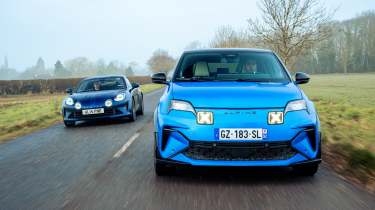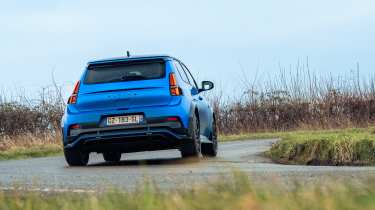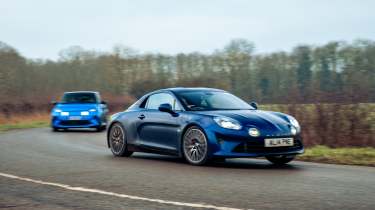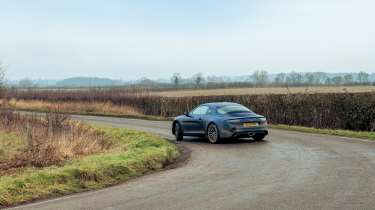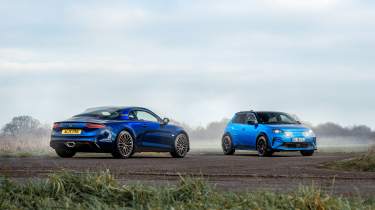Alpine A290 v Alpine A110 – how much DNA do they really share?
Alpine would like us to believe that the A290 shares much of the same DNA that makes the A110 a great driver’s car. Time to put that claim to the test
It was the question on all of our lips. At the reveal of Alpine's A390_β concept crossover last year, company execs gave a presentation explaining how the new Nissan Ariya-based EV would, in Alpine’s words, ‘transform into a racing beast like the A110’ and drive like a lightweight sports car. Hmm. For a car that could weigh as much as 1900kg in production form, that would take some doing. Then one journo simply asked, ‘But how can a heavy four-door electric car drive like an A110?’ A moment of silence from the Alpine execs as they figured out how to tackle that particular question.
Sovany Ang, vice president for product performance, stepped up. She explained that though the A390 wouldn’t be a lightweight car per se (she wouldn’t disclose an exact kerb weight), it could be engineered to feel like one. This would be possible through tri-motor active torque vectoring, floor-mounted batteries for a low centre of gravity, and a heavily modified platform to counteract the effects of the A390’s mass and make it dynamic to drive. We’ve seen how effective these tools can be in other EVs, but the A110 comparison still seemed like quite a stretch.
But perhaps not for the A290, which isn’t a lardy crossover but a compact, sensibly packaged electric hot hatch based on the new Renault 5. We’ve followed its development closely, from when it was unveiled in concept form in 2023, to a cold-weather test of a prototype and a first drive of a production car late last year. From the moment it was announced, there was plenty to be excited about – this was a fast EV that wouldn’t cost the earth, wasn’t all about wild acceleration and, most importantly, wasn’t another two-ton-plus SUV. It also promised, like the A390, to offer elements of A110 magic in a more practical, accessible package, to the extent that the sports car was used as a benchmark for the A290’s major controls and general driving feel.
More reviews
While sampling an early prototype in Sweden, deputy editor James Taylor spent time with the Alpine engineers, who revealed that elements such as the steering feel, coasting deceleration and throttle response have been designed to mimic the A110 and make the A290 feel like a true Alpine. This sounds great in theory, but how much of the A110’s DNA can be conjured through careful set-up and calibration, and how much is intrinsic to its fundamentals as a finely honed lightweight? Is building ‘the A110 of electric hatchbacks’ even an achievable goal? Driving the A290 side by side with Alpine’s decorated sports car should provide the answer.
Things don’t get off to a great start. For boring logistical reasons I arrive at the evo office well past midnight to collect the A290 ahead of the test, running short on sleep but hoping that driving a French hot hatch will be a shot of caffeine to the system. But as I climb in my mood sinks – temperatures are only just above freezing and the battery is showing 80 per cent charge, with a predicted range of just 160km (around 99 miles). Ah. I need to get to my overnight hotel with enough juice for the test in the morning, which means leaving it in normal mode, twinkle toes on the throttle and no opportunity to dig into its performance.
But the fun bits will come, and the A290 does at least immediately feel grown up, and quite special to be in. In fact it looks and feels totally fresh, much as the A110 did when it first appeared in 2018, and even in the early hours of the morning its squat, retro form attracts glances from everyone on the road – those that are left, at least. You’re not short-changed inside, either, with stitched dark blue leather surfaces, high-res displays and tasteful detailing throughout. But as in most EVs, the A290’s floor-mounted battery raises the driving position, which gives it a kind of miniature crossover feel (it is in fact wider and almost as tall as a Ford Puma), so you’re not hunkered down and completely plugged into the car. On the plus side, there isn’t an awkward adjustment period with a plethora of modes or odd EV driving characteristics to figure out. The A290 just feels like a car, with a sense of cohesion and togetherness that speaks to a careful and comprehensive development programme.
Next morning, en route to its meeting with the A110, the A290 starts to show more of its character. The first thing you notice is that despite it weighing a fairly hefty (for a traditional supermini) 1479kg, Alpine has tried to instil a sense of agility through the steering. It’s light and sharp off-centre, which gets the nose into corners quickly but can make the car feel a touch nervous if you’re not calm with your hands. It’s also clear that the A290 isn’t going to be the next YouTube drag-racing superstar, which is fine by us. This 217bhp GTS model is quick and there’s enough performance to scamper along and work the chassis, but torque from the single front motor arrives progressively rather than in one big lump, helping you get into a fast, satisfying rhythm. Go deeper into the throttle and you start fighting torque steer, the steering wheel tensing up and jinking around, particularly over bumps.
Being based on the Renault 5, the A290 benefits from having a multi-link rear axle, tackling bumps with the sort of control that you’d normally expect from a bigger, more mature hatch. The dampers are passive and there is an underlying firmness along tricky surfaces, but the A290 is never harsh or unyielding. Hydraulic bump-stops unique to the A290 play a part here, giving the suspension more bandwidth and control near the end of its travel – a solution shared with the last Mégane RS.
Fellow staffer Sam Jenkins arrives at our meeting point in the A110, and he’s completely smitten. ‘I haven’t driven a base A110 before – it’s mega!’ he enthuses. The A290 hasn’t given me that same instant buzz – unsurprising given it’s not a bespoke £55k sports car – but I’m keen to find out how much of its character can be traced to the A110. Though quicker, stiffer and more aggressive variants have come along over the years, Alpine’s unique approach to sports car dynamics is clearest in the original – making it a perfect reference point for the A290.
The size difference between the two is dramatic and serves as a reminder of just how slim and cleverly packaged the A110 is. The A290 has the appearance of a supermini that’s been blown up to 110 per cent scale – it’s not dainty and delicate like the A110, but that’s the price for a much more useable cabin and rear seats that can just about fit a pair of adults. The floor-mounted battery (52kWh, lifted from the higher-spec Renault 5) also plays a part in raising the overall profile of the car, but the general proportions are akin to those of a classic hot hatch, with the wheels pushed out to the corners and 60mm wider tracks than the R5’s. To these eyes it’s a far more appealing shape than the amorphous Volkswagen ID.3 or Cupra Born and certainly looks part of the A110’s family tree.
Unlike rear-drive electric hatches, the A290 packages its motor and control box under the bonnet, giving it a more conventional bonnet line and a front-biased 57:43 weight distribution. Visually, there’s no obvious giveaway that it’s an electric hatch, and you sense that a similar approach has been taken with the A290’s dynamics, which don’t feel new or unusual for the sake of it.
Conversely, the A110 has always felt different to everything else, for all the right reasons. Like the A290, it’s not a numbers car – this base A110 develops a relatively modest 249bhp – but getting back into one is always a joy, and a reminder of just how absorbing a sports car can be when stripped back to the bare essentials. Having said that, it doesn’t feel as bare-bones as I remember. Yes there are low- rent plastics and an infotainment system that appears to have been lifted from a low-end Suzuki (because it has), but the (optional) diamond-stitched Sabelt bucket seats, satin carbon trim and quilted door panels really lift the cabin. A bit like how the A290 uses funky detailing and material finishes to enhance what would otherwise be a humdrum environment.
Within just a few miles I’m completely besotted. Everything gels and I’m not thinking about the A290 but about how wonderful the A110 feels on what should be an evil stretch of road in a sports car, littered with sudden dips and broken surfaces ready to catch splitters or bend a wheel out of shape. It’s lapping everything up with a calmness that Lotus owners will recognise, including bumps that gave the A290 more of a challenge. Combine this with a chassis that can be neat or lairy, feelsome steering and a peppy 1.8-litre four-pot at your back, and you have the makings of an addictive, engrossing driving experience. We’re not here to find out whether the A290 is as outright rewarding as an A110 (how could it be?) but its character is certainly less bright and distinctive.
However, once you home in on exactly how the A110 delivers its magic, there is a common thread that links the two. Neither is about all-out aggression – the satisfaction comes from the sense of progression and flow, rather than how much speed you can carry (though that is quite a lot in both cars). And you can feel a relationship between some of their controls. The A290’s brake pedal in particular has a similarly progressive feel to the A110’s – not surprising given that the front calipers are derived from the sports car’s, but impressive given that they’re blended with regen – and the initial pick-up from the motor in Normal mode isn’t far off that of the A110’s ICE unit.
The steering, however, doesn’t match the A110 for feel and response. The two-seater’s rack is firmer and more positive in its weighting yet also calmer off-centre, which makes it easier to pour through corners in a single fluid motion. Switching to Sport mode in the A290 adds steering weight, but it’s still a little too light and sharp for my tastes. Speaking of modes, you can switch between regen settings via the blue rotary controller on the steering wheel, which supposedly mimics the switch found on Alpine’s F1 cars. The lowest level is modelled on the engine braking effect from the A110’s motor, which it matches quite closely. There isn’t the heaving deceleration you get in some EVs as the regen ramps up, and instead you can float into corners off the throttle, spot your exit and blend the power back in smoothly. This is one of few EVs that might not make your passengers turn green when driving quickly.
When you do ramp up the speed, the A290 can feel a little busy – particularly compared with the A110 – in how it delivers its performance. The ride remains well controlled, but keeping the nose precisely on line under full power requires concentration as the front wheels latch onto ruts and cambers, sometimes in a straight line. For some this will add to the fun, but I find it distracting at times, particularly after the calmness of the A110. The A290’s fundamentals are sound, though, the handling neat and intuitive. It doesn't have a mechanical locking diff, but the front end still finds good bite and traction, and if you lift off into a corner you can feel the rear taking an attitude to set you up for a straighter exit. It’s not as expressive as Renault Sport hatches of old, or the A110, but there is fun to be had – and you sense that an A290 S or R would unlock an extra edge to its performance.
As it stands, the A290 does feel like an Alpine, but perhaps not in the same way that a Taycan feels instantly like a Porsche. Then again, the A290 is the first modern Alpine that isn’t a sports car, and Porsche has had far, far longer to define the character of its cars across a variety of genres and that feel is now very familiar.
And to answer our original question: no, I don’t think it’s possible to transplant the A110’s character into a conventional EV, at least not with current tech and without compromises. But by using it as inspiration for the A290, Alpine has produced a likeable, fun and rounded performance EV, which could really come to life if and when a harder-edged variant arrives.

